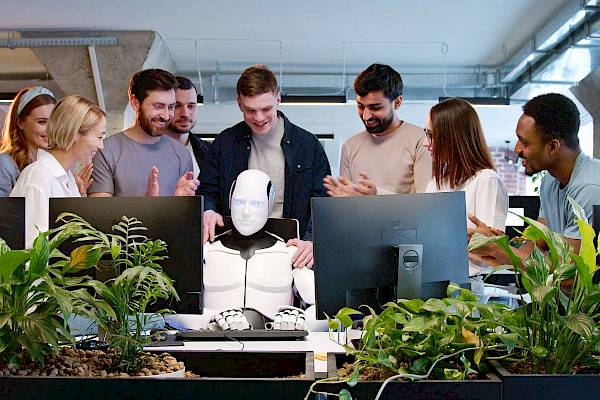In this month’s edition of Target Tech Bytes, we demystify the topical subject that is Digital Twin technology. Let’s explore the ultimate doppelgängers, delving into their fundamental principles, applications across various industries and the boundless possibilities they hold for this digital-first era.
Before we go any further, let’s look at McKinsey’s definition of Digital Twin:
A digital twin is a digital representation of a physical object, person, or process, contextualized in a digital version of its environment.
A little background
The concept and practice of Digital Twin technology can be traced back to the 1960s with NASA’s solution for fixing the damaged Apollo 13 spacecraft. The world held its breath in anticipation whilst NASA created duplicated systems at ground level that mirrored those in the spacecraft. The systems simulated onboard conditions, allowing engineers to test solutions more than 200,000 miles away. A technique that brought it safely back to earth.
The technology leapt forward in 2002 when Dr Michael Grieves, a NASA consultant, applied the concept and model to the manufacturing industry. In 2010, NASA’s John Vickers introduced the term ‘Digital Twins’ to this concept.
Since 2010, Digital Twin technology has expanded into other industries and Digital Twin of the Customer has also made Gartner’s Hype Cycle of emerging technology in 2022 as having the potential to transform organisations.
Let’s explore more!
A Digital Twin is a dynamic, virtual representation of a physical object, person, system, or process. It mirrors its real-world equivalent in a digital realm using data and algorithms to analyse, predict and simulate its behaviour.
A digital twin can be a replica of anything from an engine to a wind turbine to a whole building or person.
Using specialised software, 3D models and sensors, a digital twin collects real-time data and creates a simulation and replica of the physical object or process. The technology can be combined with other technologies such as Artificial Intelligence to enhance output and predict how the real-world twin will perform.
Research conducted by McKinsey’s found that 70% of C-suite technology executives in large companies are exploring and investing in digital twins. This is a contributing factor, along with evolving technologies, in driving estimates of investments in digital twins of more than $48 billion by 2026. This statistic shows that digital twins are a key factor to digital transformation.
Types of Digital Twins
There are many applications of Digital Twins, the most common types are:
- Component twins – also known as part twins, this type represents the model of individual components or parts, such as a screw
- Asset twins – also known as product twins, are models of physical assets/product rather than individual parts, such as an engine
- System twins – also known as unit twins, are digital models of entire systems or processes. It allows you to see a range of assets/products work together to form an entire system
- Process twins – digital models of an entire process or system working together.
The three elements of digital twins
Digital twins are made up of three different elements:
- A physical entity
- A digital twin in software form
- Data that links the above two elements together proxy
Benefits and challenges
In this digital transformation era where automation, analytics and evolving technologies are key, digital twins could be the solution companies need to place them ahead of competitors.
As with all technology, there are benefits and challenges, let’s look at a few examples:
Benefits
- Reduce lead time to market – digital twins can give firms continuous insight into how their products are performing, allowing them to tweak and innovate products to market faster
- Enhance customer experience and satisfaction – drive efficiencies and improvements to products by virtually modelling a customer journey to identify pain points and address them quickly
- Improve decision making – data-driven insights from digital twins can give firms the power to make better decisions based on accurate, real-time data
- Develop testing and validation – the technology allows organisations to test new processes, products and more on a virtual system to see how they perform without any impact on the real-world twin
- Predict issues before they occur – depending on the application of the technology, the digital twin can use the input data to predict issues before they occur, such as fraud detection or system issues.
Challenges
- Only as good as the data that is uses – If the data used by the digital twin technology is biased or incomplete, the predications and simulation output won’t be reliable
- Cost to implement – as with most new technology, significant investment is needed to implement digital twins within an organisation. Depending on the application, it could be accompanied with substantial costs
- Security – The amount and type of data collected by digital twin technology poses a cybersecurity risk. Valuable data that, if fallen into the wrong hands, can harmful. Cybersecurity must be a key priority when implementing the technology
- Fear – A suspicion that human jobs will be replaced as digital twins can bring increased automation and accuracy and help companies save money on labour.
Leveraging digital twins in banking and financial services
Digital twin technology has the potential to disrupt the banking and financial services sector and could change how customers interact with their banks entirely.
Virtual replicas of systems and processes allow for testing, monitoring, and analysis to help optimise them without impacting the customer experience. Examples could include a digital twin of a bank’s loan origination or settlement process from end to end.
Another example of how this technology can prove pivotal for this sector is the concept of Digital Twin of the Customer (DToC), which Gartner predicts has the potential to transform organisations.
By creating digital twins of their customers profile, organisations gain valuable insights into their customers preferences and behaviour, in real-time. This can help them provide products and services tailored to the customer and build stronger relationships.
Who is using digital twin technology
From manufacturing to healthcare and aerospace to retail, there’s many sectors already realising the benefits of using digital twin technology. Some sectors are more advanced than others when it comes to their digital twin solutions, below are just a few examples.
Rolls-Royce use digital twins for their ‘IntelligentEngine’ programme. A twin is created for each engine they produce to monitor and predict maintenance needs to enhance customer experience.
Pharmaceutical company Pfizer uses digital twins to simulate new drugs' behaviour in cancer patients' treatment, allowing them to identify any potential side effects and test its effectiveness.
How can digital twins benefit your business?
In the rapidly evolving digital landscape, the development of digital twin technology is expected to play a key role in the transformation of many sectors.
With any innovative technology, there's legitimate concern and resistance to change. As the world of work continues to adapt to the pace of digital transformation, job roles will evolve accordingly. Digital twins won't replace humans' critical thinking, informed experience, and problem-solving skills. Instead, they're a tool to supplement human workers by freeing up expertise and allowing them to focus on critical analysis, strategy and developing new products and services.
Becoming an early adopter and integrating digital twin technology into your business could help deliver products faster, improve accuracy, understand your customer in more depth and deliver better customer experience.
Sources
https://www.gartner.co.uk/en/articles/what-s-new-in-the-2022-gartner-hype-cycle-for-emerging-technologies
https://www.mckinsey.com/capabilities/mckinsey-digital/our-insights/digital-twins-from-one-twin-to-the-enterprise-metaverse
https://www.coursera.org/articles/digital-twin
https://www.mckinsey.com/featured-insights/mckinsey-explainers/what-is-digital-twin-technology
https://www.techtarget.com/searcherp/definition/digital-twin
https://www.mckinsey.com/industries/industrials-and-electronics/our-insights/digital-twins-the-key-to-smart-product-development
https://www.toobler.com/blog/digital-twin-examples
https://research.aimultiple.com/digital-twin-applications/




